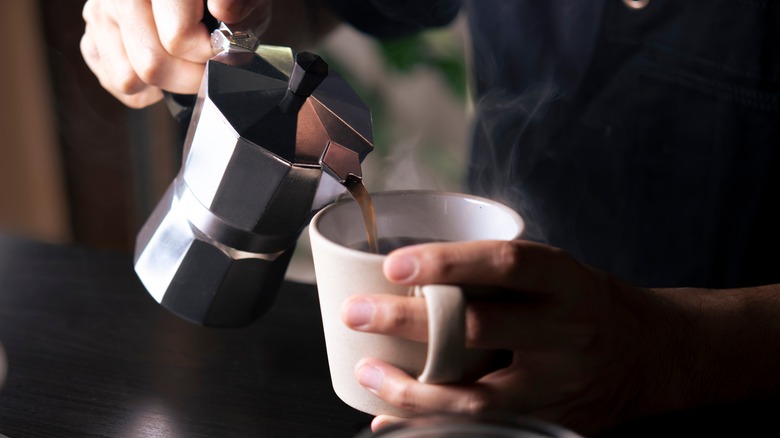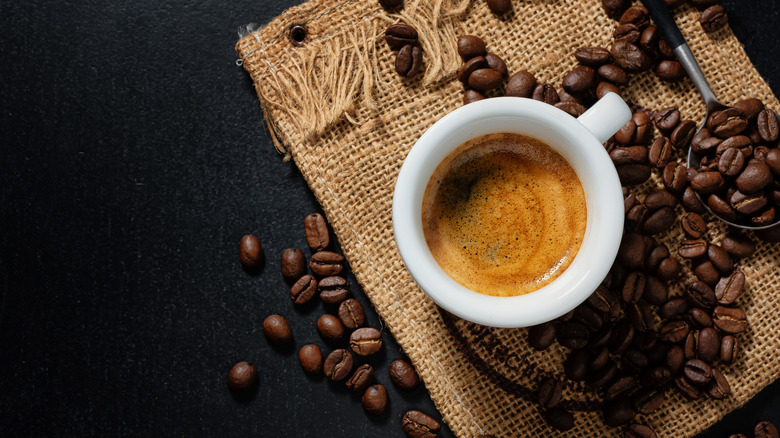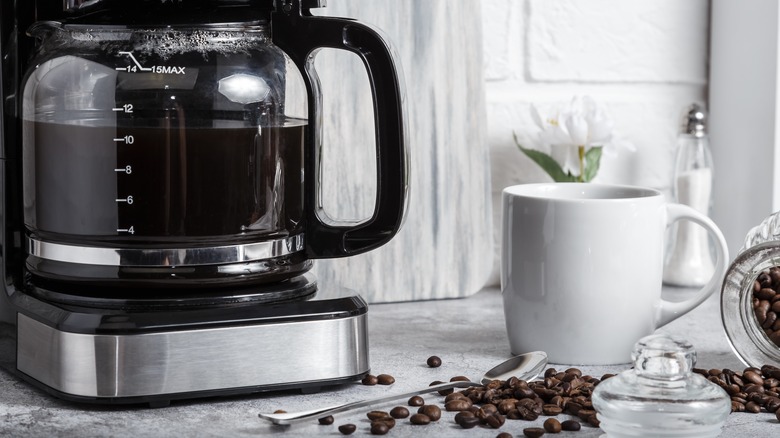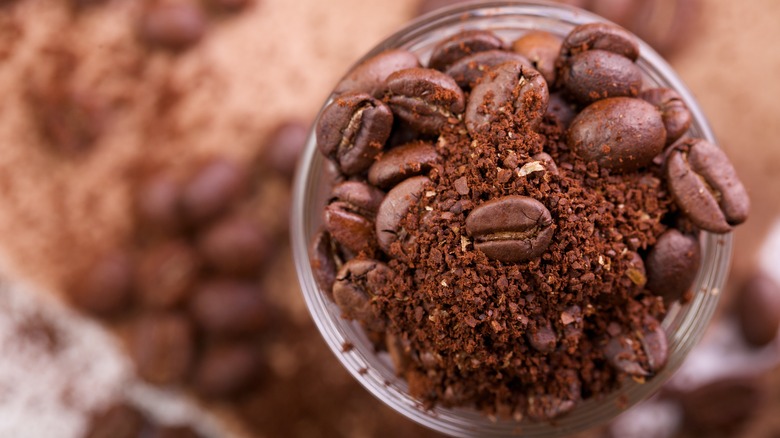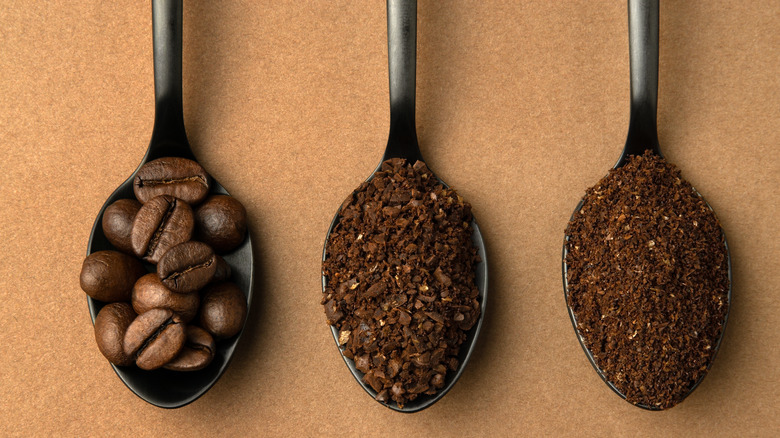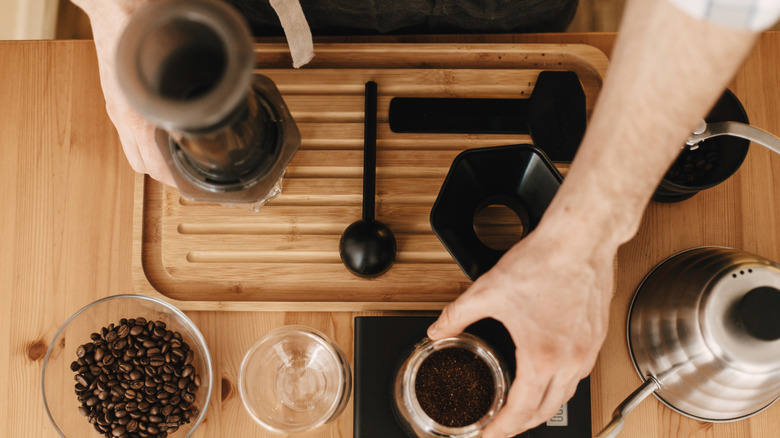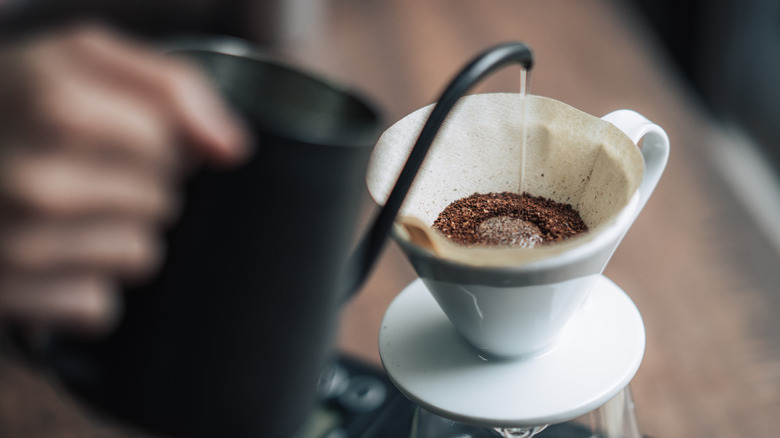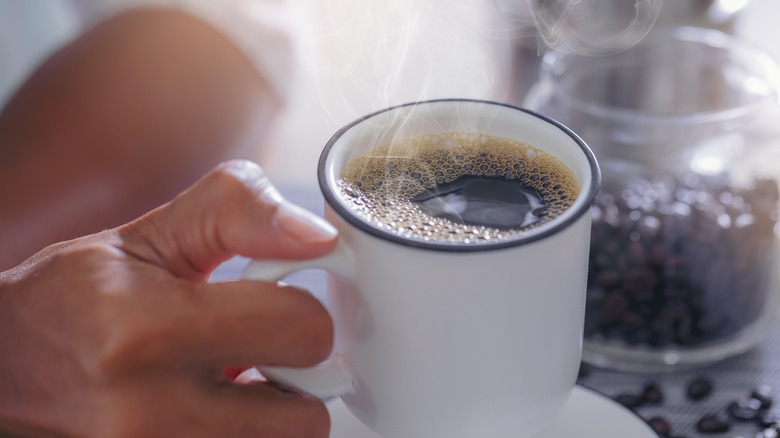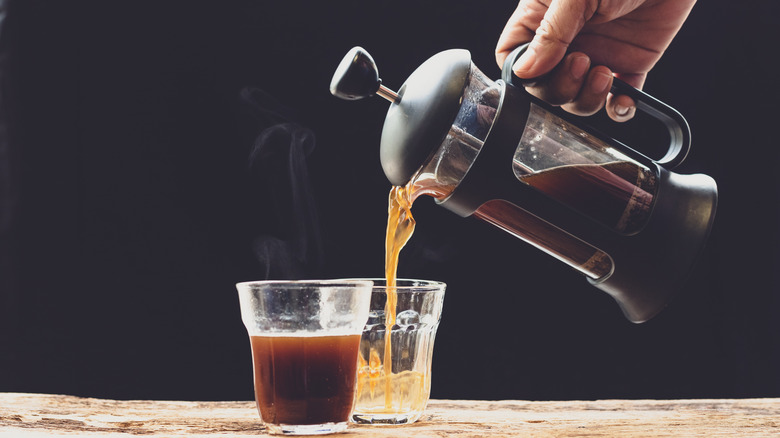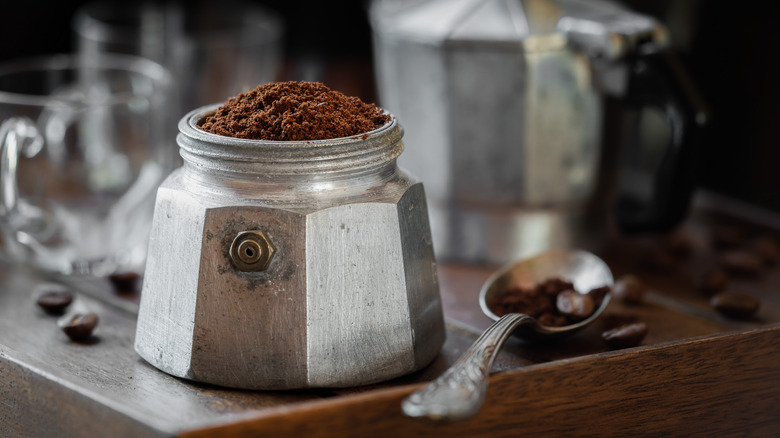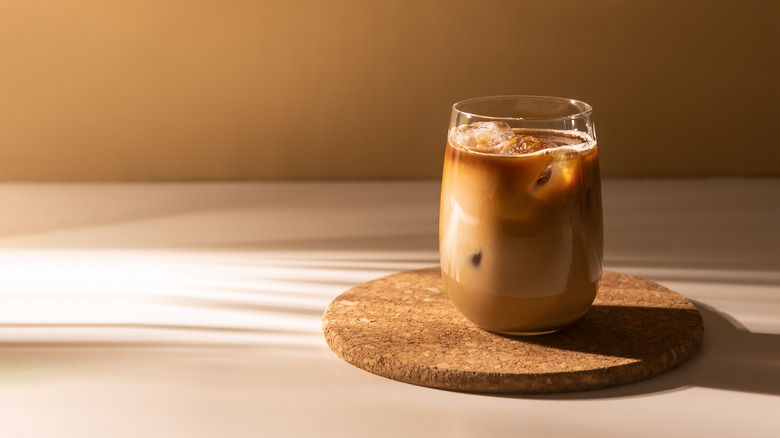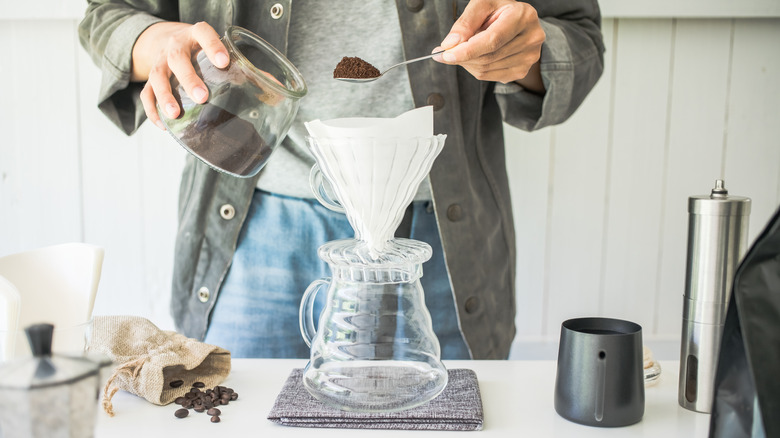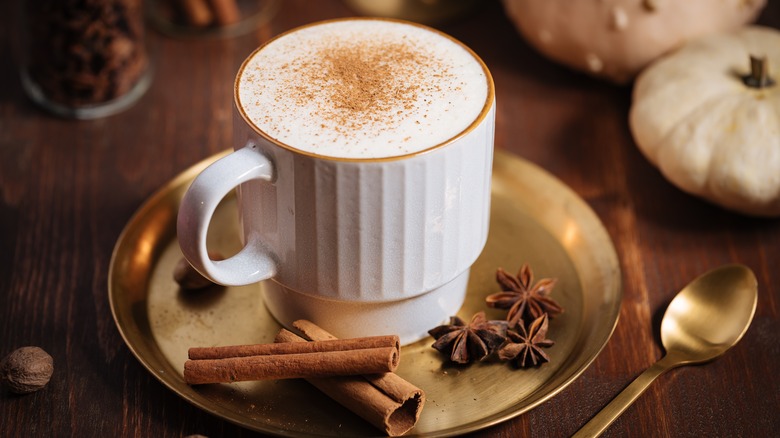The Biggest Mistakes You're Making When Brewing Coffee At Home
We may receive a commission on purchases made from links.
The start of each day hails the symphony of morning-time: birds trilling, the household stirring, and the chirp of a coffeemaker coming to life. Through countless combinations of brewing methods, bean types, and add-ins, no two cups of coffee are the same. Making coffee at home can save you money and time from daily commutes to the cafe, but it can also instill a newfound love for experimenting with this versatile and complex bean. Over 70 countries produce coffee, per We Forum, so you'll never run out of new options to explore. From classics like the much-beloved Ethiopian Yirgacheffe or underrated harvests out of India's relatively young coffee market, options are abundant. Further, coffee partners magnificently with many other flavors, like warm cinnamon, fresh cream, or even sweet vanilla ice cream. Several kitchen staples marry well with coffee, as well as dozens of flavors of store-bought coffee creamer brands.
The taste of a brew is impacted by more than you may think: water temperature, grind texture, and even the humidity in your kitchen air. Whether drinking coffee is a sanctioned morning ritual or a quick means to a caffeinated end in your daily routine, there are mistakes you should watch for that may be holding you back from the best cup of Joe you've ever made at home.
Using pre-ground coffee beans
Coffee is a storyteller of flavors, and all those flavors stay packed inside the bean until it is ground open. Once ground, the clock on a coffee bean's shelf life starts ticking. From grinding, to packaging, to shipping and distribution, then purchased and consumed by you, there could be months between processing and drinking. And yet, the first few moments after being ground are the most crucial for retaining flavor.
We aren't exaggerating when we say the first few moments — beans lose most of their natural flavor potency in just 10 minutes to half an hour (via Java Presse). Ground coffee oxidizes much faster than the whole bean, making it far less suitable for long-term storage (like the amount of time needed to travel from a warehouse to the grocery store and then to your kitchen). As a bean oxidizes, its sugar and acidic components begin to decay and disappear. If you've been buying pre-ground coffee for years, the first use of freshly-ground, whole-bean coffee will blow you away and awaken your tastebuds.
It's not just the realization that there's more out there than stale, bitter, boring grounds that make you grimace with each sip — buying whole beans (and a grinder to process them with) gives you more control over the different brewing methods you can use. And, it will save you money in the long run, too, says Full Coffee Roast.
Pouring a cup before the drip brewer is done
It's early, you're still sleepy-eyed, and the coffee brewing smells irresistible. You're often tempted to sneak a pour before the brewing is complete — but not so fast. Most coffeemakers may have 30-second pause features that stop brewing when it detects you've removed the carafe, but using this function will throw off your coffee's flavor. The ratio of grounds to water is important to maintain the desired strength and taste.
Taking a cup from a batch that's just started brewing will yield you a much stronger coffee than intended; the first drops of water to pass through the dry grounds will be the most concentrated, more similar in powerful flavor to espresso than normal drip coffee. While this intensity is favorable for some, it can be difficult to palate in a standard-sized coffee mug. As the brew continues and more water infiltrates the coffee grounds, it will get closer to the mild-strength java we associate with drip brewers. If you're determined to swipe a cup from your brewer before its cycle is done, the best time to do so is when the brew is at least halfway complete.
Grinding beans too coarse
Picture a jar full of small pebbles with drain holes in the bottom. If you pour some water over the small pebbles, the liquid, following the force of gravity, will race quickly around the rocks and out of the drain holes with minimal hindrance. Now, if those pebbles were actually coffee grounds, this means that the water passing easily through the larger particulates won't be forced to slow down and absorb the coffee's flavor and caffeine.
If your coffee tastes too acidic or sour, your grounds might have been too coarse, leading to under-extracted coffee. Course grounds are preferred in some brewing methods. If you're brewing with a pour-over, your grounds should be medium-fine, but if you're making espresso or Moka pot, bump your grinds up to fine. An Aeropress can take grounds anywhere from medium-fine to fine, depending on your brewing time, but Turkish coffee — a traditional brewing method where the grounds are boiled with water and poured unfiltered into cups — requires extra-fine beans. According to Barista Magazine, the grind size doesn't only affect permeability and flavor: A finer cut will result in more of the caffeine you crave.
Grinding beans too fine
Let's update our visual demonstration to have sand in our jar instead of pebbles. With far less free space to race around the sand to the drain holes, the water will be trapped within the jar longer. The same is true of water passing through finely-ground coffee; more caffeine and flavor elements will be drawn from the grounds as the water trickles its way through the smaller particles.
If your coffee is bitter but otherwise quite tasteless, it may be over-extracted due to too-fine of a grind. Since flavor and caffeine extraction comes from fine-ground beans, the finer, the better might make sense in theory, but in practice, you can draw too much out of your coffee grounds by using the wrong grind size with your preferred brewing method. You can remedy this with a coarser grind setting, decreased brewing time, hotter water, or all of the above. Medium grounds will work for drip coffee machines, long brew times on Aeropresses, and pour-overs (if you prefer a less intense coffee taste). Use coarse grounds for percolators or a French press, and extra-course coffee to steep your cold brew.
Not testing new brewing methods
It's hard to let go of your trusty old Mr. Coffee machine, but there's a vast world of coffee brewing out there waiting for you. Different methods can entirely transform the taste of your brew: some, like the French press, will create a velvety and rich drink, while the Aeropress creates a vigorous, espresso-like craft. To transform your coffee-at-home experience, branch out and delve into some other brewing gadgets. Some will be plain and simple, and others are more for the coffee drinking enthusiast.
Pour-overs are one of the easiest and fastest ways to make coffee. The method uses what's called a coffee cone, which sits on top of a cup or carafe and holds a coffee filter. To use a pour-over, slowly pour hot water over the grounds in the cone. Pour-overs are perfect for making single-serving coffee portions — and will taste 10 times better than Keurig coffees, too. The Chemex is a specially-designed pour-over flask that uses a custom filter. While some say the taste of a Chemex pour-over will be more floral and sweet than the smooth and round standard pour-over (due to its different cone shape and unique filters), the difference is minimal to most coffee drinkers. The Aeropress is a newer brand of press coffee where the pressure of a plunger forces hot water through coffee grounds into a small brew chamber at the bottom. This method makes for a robust, espresso-style coffee.
Adding water too quickly in pour-overs
The easiest way to mess up a pour-over coffee is by incorrectly pouring the water, since this brewing method relies on gravity to bring the water down through the grounds. If you pour fast and hard, the water will be forced through too quickly, and your coffee will taste bland and weak. Likewise, pouring only in the center causes over-extracted grounds in the middle and under-extracted grounds around the edges. Because the liquid is looking for the easiest route of least resistance through the grounds, improper pouring will force the water to create channels through the coffee that easily run out without steeping and soaking up the flavor and caffeine.
You should be using hot but not boiling water and about double the weight of the coffee grounds in quantity. To start the brew, position your gooseneck kettle over the center of the grounds and saturate the center for the first few seconds (this is the deepest part of your filter, so not giving it some extra water will cause under-extracted coffee). Then, continue your pour in slow, even, concentric circles moving away from the center. The closer you get to the coffee filter, the less water is needed; once you've reached the edge, don't start pouring back in towards the center, but rather begin pouring in the middle again and repeat the process until you've reached the desired amount of water.
You're using boiling hot water
Everyone loves a steamy cup of coffee, so the temptation to use the hottest water possible is understandable. However, you're setting yourself up for a burned, bitter-tasting brew if you use water fresh off the stove. When you brew coffee with boiling hot water, you're introducing too high of heat to the coffee grounds, which will allow the water to over-extract the beans immediately. This takes too much from the grounds too early, and your coffee taste will be worse for it.
Your water should be on the brink of boiling for the perfect brew — somewhere between 190 and 205 degrees F. If it's not hot enough, your H2O won't properly react with the coffee and can actually be under-extracted for a sour and bland result. You can use a thermometer or an electric temperature-controlled kettle to monitor the water's temperature. If those aren't available to you, just watch it as it heats and try not to let any bubbling or boiling occur. If it does, let the water sit for a minute off the heat before pouring it over your grounds.
Letting French Press grounds steep for too long
A French press — or coffee plunger, coffee press, press pot, or cafetiére, whatever you know it by — is a popular choice for at-home coffee because of its smooth and bold brew. This method works by putting coffee grounds in the carafe and then pouring over hot water. The grounds and water are left to steep, then a fine mesh strainer, attached to a handle that the user pushes down, plunges through the coffee and presses the coarse grounds to the bottom.
There are a few ways to adjust the strength of French press coffee. You don't want to grind your beans too fine because, then, they will easily filter through the mesh strainer into your coffee. You could change your water-to-beans ratio: less water will mean a stronger taste. Letting the water and grounds steep for longer than three or four minutes will also create a bold coffee — but much more than that and your coffee will over-extract, yielding a burnt bitterness on your palate. This is one of the biggest downfalls of French press coffee; you shouldn't brew more than what will be immediately consumed, because the longer the grounds and water are left to mingle, the more extraction that will occur. Anything more than five minutes is very likely to botch your coffee.
Not letting coffee grounds bloom
A perfect cup of coffee is one where the grounds have been given a bloom period. The bloom is the moment when the first drops of water meet the coffee. The grounds will bubble and rise as CO2 gasses inside are released (via Savorista). This is the sign that the extraction process has begun. Once you observe the bloom beginning, let it continue undisturbed (don't add more water if using a pour-over and don't stir if using a French press). After about 30 seconds, the bloom is likely over and the brew can continue.
Dark roasts will have a larger bloom than light roasts, due to the additional gases that were created over the bean's longer roast time. The bloom is an important sign that your coffee is fresh and the flavors were preserved within the beans — so while some roasts bloom larger than others, no bubbling or rising at all may be a sign that your coffee is stale, old, or wasn't properly packaged.
Overlooking instant coffee
Instant coffee often gets a bad rep in the coffee world. Instant coffee definitely doesn't make as good of a plain black cup of Joe as other methods, but that doesn't mean it should be written off entirely. Combined with yummy ingredients like cream, chocolate, ice cream, and sugar, this underdog of java can be transformed into many other types of coffee. A container of instant coffee should be kept in the recesses of every coffee lover's cupboard as a backup when you run out of beans and when you're looking to shake up your routine.
There are over a dozen drinks that can be made with instant coffee (via Insanely Good Recipes). Instant coffee makes a great iced coffee, dressed up with milk and sugar, but that's not all. You can add any coffee syrup or caramel sauce to jazz up the iced coffee's flavor, but instant-type grounds can make Dalgona coffee, where a foamy combination of instant coffee, boiling water, and sugar is poured over a cup of cold milk. Use your instant coffee to make a cozy mocha latte by combining the coffee with a packet of hot cocoa mix and hot milk (don't forget to top with whipped cream and a dash of cinnamon). Shake together instant coffee, sugar, milk, and ice to make the Greek frappe, a creamy and frothy summer treat. Instant coffee can also be added to almost any baked good or sweet, from pudding and truffles to cookies and ice cream.
Not saturating your filters
It might make you groan to add additional steps to your coffee-making routine, but we promise they are all worth it. If you are using a pour-over brewer or a drip coffee machine, you should soak your filters before filling them with grounds. This will rinse any dust, sediment, or other impurities off the filter, so they don't end up in your coffee. It will also help your coffee to extract faster and more evenly since it doesn't need to spend time saturating the filter and will discourage the channeling of the water.
This practice is widely accepted by some and deemed a myth by others, so if you're skeptical and want to see results for yourself, we recommend using the Coffee Magazine experiment and making two side-by-side batches, one with a pre-wet filter and one with a dry filter. Even if you don't find any noticeable improvements in taste from wetting the filter, rinsing off any debris certainly doesn't hurt.
Not exploring new flavors
On its own, the flavor of coffee can be smoky, citrusy, sour, or chocolatey — just to name a few. Enjoying these notes individually is always a treat, but so is combining the complexity of coffee with another favorite ingredient. There's likely a handful of things waiting in your kitchen that will elevate your humble morning java.
If using a drip brewer, drop a whole cinnamon stick and a few slices of ginger root in the carafe before the cycle starts. The coffee will steep with the spices and create a warm, naturally flavored beverage reminiscent of gingerbread cookies. With pour-overs, Areopresses, or espresso machines, put a square of your favorite decadent milk chocolate in the cup or flask your coffee is being brewed into. As the chocolate meets the hot coffee, it will melt into a rich and sweet mocha. Cocoa powder, vanilla extract, sugar, mint leaves, and whole spices like cardamom are fantastic editions to French presses — be sure to put the large particulates in before plunging, so they're pinned down by the filter and not free-floating in your coffee. Pumpkin puree can be vigorously whisked with heavy cream to create a frothy topping for cold brew perfect for fall. Experiment with your favorite combinations of herbs, spices, and other add-ins to transform your coffee with quality, natural ingredients.
